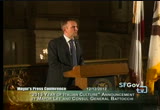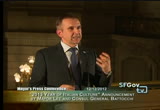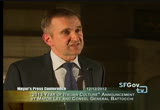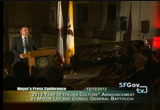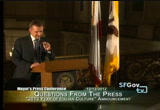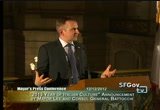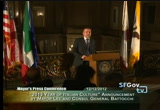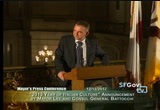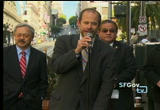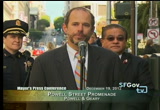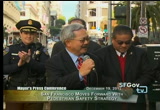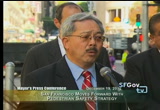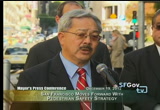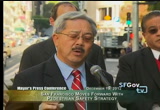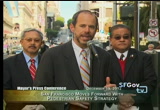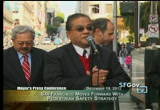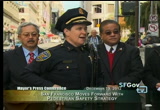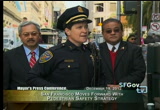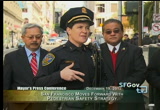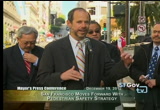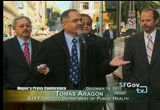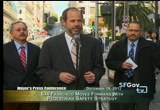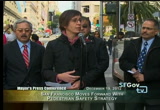tv [untitled] January 11, 2013 4:30am-5:00am PST
4:30 am
montgomery street, 814 montgomery street. we will have jazz, opera, good slow food and opportunity for all of us to mingle and have a good time. i wonder if there is someone in the press that is following us if they want to ask questions? please. >> [inaudible] you mentioned sustainability. do you define italy as a green country and what do those efforts mean for san francisco. >> yes, definitely. i see that. i am happy while being in san francisco there is such an amazing attention to the environment. people are very environment conscious and i see community aggregations also to
4:31 am
have renewable energy. it makes me very happy because in italy we have been following this path for a very long time. for example in the first six months of this year we installed photovoltaic panels larger than the united states all put together. it shows you the extent of the revolution happening. i am sure italian companies will be happy to work with the local institutions that have started to generate projects that will somehow go in that direction, and also we want to have parties and communication activities to show the people in the street that it is important to have sustainable behaviors and not to leave a carbon footprint behind us.
4:32 am
>> [inaudible] >> yeah, if i understand correctly because -- you said about the innovation -- if we? >> [inaudible] >> yeah, okay. well, we're going to have in the museum of computer science in mountain view an exhibition show casing what italians have done to create silicon valley. i mentioned one person but there are many other examples. along with that we will have a big conference with italian innovators and venture capitalists and along with large hi tech companies of silicon valley and come together and focus on specific projects how
4:33 am
to work together for technological innovation. it will be focused on silicon valley but also the cultural institute in san francisco we have surprises for you that we're preparing. any other questions? >> [inaudible] >> yeah. >> [inaudible] the problem of the public -- i would like for you to answer it -- [inaudible] >> i try not to be technical, but i hope i would be pervasive just telling you the debt crisis is basically a crisis connected to the governments of the euro system that has hit some
4:34 am
countries for some reasons. somewhat we were hit because of the sins of our past. we have been having -- we have had a relatively a sizable but stable debt for a long time, but the point is it's very manageable. we are reducing it pretty fast, very fast indeed, and also to reassure the investors if you put together the net household wealth of italians as compared to the debt of the government and the companies the ratio is three to one, so it's a matter of redistribution somehow. italians thanks to god are a wealtdy people and the matter is how we can put things into order in our household but definitely italy is a major stable solid economy, and once -- already there are signs of strong
4:35 am
improvement. once this crisis is over we will definitely flex the muscles. please. >> [inaudible] are you planning show case any important architects and designers in this year of italian culture? >> definitely. i mean in san francisco there's a wonderful san francisco design week, so we will have an italian design week too. we are planning on an exhibition of cultural institute with major brands of interior design. there's also very nice thing that we're working on. a famous architect has designed the california academy of sciences, the wonderful
4:36 am
building in golden gate park. he has also designed similar museum in italy in my city and the museum is almost finished there, and our ambition is to have him come over and celebrate at the academy, and also talk to young architects about the most sustainable ways to build this century. other questions? if there is no other question i thank you so much. thank our distinguished guest for being here with us and i hope to have a good time with you guys at the italian cultural institute. thank you. [applause]
4:37 am
4:38 am
charged with implementing the city's transit first policy. and what our goal, what the city's goal and the transit first policy is is to make sure that everybody can get around san francisco, that everyone can get to where they need to go. it is an important part of making the economy of san francisco work, to making the quality of life good and better. but it's not just get around san francisco any old way. this is san francisco, and we have values that we bring to our transportation system. we want people to get around in a way that steps lightly on the environment. we want people to get around in ways that are enjoyable. and that really contribute to what makes san francisco special, such as our wonderful cable cars. but above all, we want to make sure that people can get around the city safely. it's no good to have a great transportation system if people can't get around safely.
4:39 am
people need to not only be able to be safe, but to be able to feel safe, and nowhere is that more important than when you're on foot because that is when you're arguably the most vulnerable. it's also how every trip starts and ends. and many trips in san francisco, and we want more of them in between, to be on foot as well because it's a nicer way to enjoy the city. but if we want people to be out and walking, we need them to be safe. we want them to feel safe, and that's what we're here to talk about today. and none of that will happen without great leadership. so, without further ado, happy to bring up our great leader, the mayor of the city and county, ed lee. (applause) >> thank you. thank you, david. i'm the other ed. happy holidays, everybody, and thank you for being here. we are initializing our
4:40 am
pedestrian safety, pedestrian strategy, and we've had a task force that have included our police department, our mta, our public works department, our health department, as well as advocates in the community with walk sf. and i noe elizabeth is here today, and she'll be speaking as well. * we are one of the most walkable cities in the whole country, and we encourage that. we want that to happen. and we're here today on the power promenade because it's one of the best examples that we have done in recent years where we have combined the physical elements of widening the sidewalks, of creating park lets, of encouraging people to shop and visit and do all the fun things that we do. * powell promenade we probably at this time really challenge ourselves as a city to make walking even more safe. and even though there's more people walking, there's local
4:41 am
visitors, there's shoppers, there's international visitors coming, and they utilize our streets and the sidewalks even more. we have to do more. we can't be satisfied with just what we've done before because we have the data that shows us more and more where the hot spots are all over the city. and we have also been concentrating on what makes a neighborhood more dangerous for pedestrians, what makes a neighborhood more safer. and i suggest to you tonight that -- or today that in our downtown area is probably one of the most safest areas to walk buzz we pay a lot more attention to that area. but there are a lot of other places where we haven't considered the issues of lowering the speed, as we've done around our schools with walk sf. we haven't done enough study around the data, completed the data of collision and pedestrian injuries as well as we should have to make it safer. so, our pedestrian strategy
4:42 am
really is in draft form. we have completed it in this month, and we plan to introduce it throughout the various public agencies and commissions and allow it to be publicly vented. but we do have two very solid goals, and that is by 2016, we want to reduce the number of serious or fatal pedestrian accidents by 25% in the next four years. and by 20 21, by 50%. we want to reduce that number. that's a great goal. we've always got to drive ourselves with reasonable but serious goals to reduce these pedestrian fatalities, and we know we can do it because on various streets where we've given it the kind of treatment that we've had, we've increased the amount of safety efforts. it has helped. and with mta, with our police department, with our health department, with our advocates in the community and our
4:43 am
schools and everybody else, the other part of that strategy and that goal is to do a much more serious education marketing campaign. we've got to educate everybody using our streets. so, we're choosing today in the middle of the beginning of our holiday season with everybody's attention on having great fun, having wonderful events, having serious sales that allow people to shop, this is where the consciousness has to be risen. and, so, in light of this, we picked this day and this time and this area of year to make this announcement that we have a pedestrian strategy that's going on, a serious one. we're jointly doing it with the collaboration of all the different departments. we have asked and part of the strategy will be our police department, really doing a lot more enforcement strategically in all the areas that we need to, with not only stops, not
4:44 am
only enforcement and ticketing, but a serious effort to remind people that these are going to be spots where we are going to pay a lot more attention. we have the mta, with ed's leadership and his staff, parking and traffic and others, working to do some of the physical improvements that remind everybody that we emphasize pedestrian use, more walking in the city, but also the safetiness of it by safety areas. with our school districts, obviously working with walk sf and the wonderful leadership in our schools and in our communities, educating everybody and helping us create the very good marketing education campaign that we need to remind everybody to do so. and then our health department, of course. they carry the very serious burden of giving us statistics, of what it is on the collision as well as injury rates and
4:45 am
reminding us that a healthier city could be one that we reduce the fatalities that happen with pedestrians. so, this is part of that whole strategy. we will consider areas of the city that we will have to lower the speed limit and enforce it and educate people around it, as well as more serious and higher and deeper ways of educating the public and the drivers as well as pedestrians themselves. this is all part of i think a good strategy, one that i'm very willing to lead and make sure every department and all of the store fronts along here, as well as people who drive cars in and out of the city, understand we're going to focus on all the hot spots and really lessen that inequality we know today, neighborhoods, people literally fear walking on our streets because there is not a presence that we've had, similar to what we've had downtown. we've had a great presence with
4:46 am
all the collaboration going on. we really mean to lessen that disparity, that inequality that happens, and make sure everybody neighborhood is safe. that will lead to more fun, more shopping, and more paying attention to all of our commercial neighborhoods across the city. thank you. >> thank you, mr. mayor. it really is the leadership that mayor lee is bringing to this. it's been a hallmark of his administration to bring the city family together to work with the advocates in the community to get things done. i think this pedestrian strategy is a manifestation that epitomizes what the mayor is doing to bring folks together to make san francisco a better place. i want to thank him for his leadership. the leadership on the ground, i think a lot of it is coming from the mta board. but the ground that i'm literally standing on here is
4:47 am
ground that used to be here for vehicles, and now it's here for people, for people to walk, to sit, to enjoy. making those decisions are sometimes difficult. they're sometimes controversial. there are trade-offs involved. but we have a very strong board of directors at the mta that has been making these decisions to repurpose, to rethink our rights-of-way, to reorient them back towards pedestrians, to make it safer for pedestrians, to narrow streets so that the crossing distances are shorter, and to really focus on the safety aspects of improving our public rights-of-way. so, i'm happy to have one of my boss as a member of the mta board of directors, jerry lee. >> thank you, thank you. i know that when i speak on behalf of the board of directors, we're really encouraged of the efforts that we're involved with in terms of being at the starting point of
4:48 am
square one. this is a critical moment for our city in terms of the efforts of making the streets more attractive and safer for pedestrians. i also want to acknowledge the work of the sustainable street division who has helped in getting these speeds at the schools reduced. this strategy will help bolster their efforts in making the city streets a lot safer for pedestrians to walk in. thank you very much. >> thank you, director lee. one of our, one of our strong partnerships is with the police department. we kind of share responsibility for managing the public right-of-way and enforcement as you heard from mayor is absolutely a part of the strategy. so, it's a very important partnership for us and very glad to have the police department so ably represented here, but more importantly, on the task force and working with us every day.
4:49 am
so, very happy to have one of the great leaders of the police department, deputy chief denise chef. >> it's a very tall man. good morning, i'm denise smith and i don't know how to work microphones. thank you. the men and women of san francisco police department are absolutely commit today working with our partners to make the walking, cycling and motoring public safer in our city. we commit to it every day, and based on information that mta has provide and had that we have from our collision data, we've launched a program called focus on the five. and for each of district stations we've provided them their five intersections or areas where they have the highest incidents for pedestrians and motorists come in contact. and we are committed to reducing those numbers. * we've got to bring these incidents down. we want the public to be able to enjoy this beautiful city. and, so, what each of the district station captains have been tasked with is developing
4:50 am
targeted enforcement and education for their five areas of highest incidents. this means enforcing what we see as the five highest primary collision factors. red light violations, stop sign violations, pedestrian right-of-way violations, turning violations, and basic speed. we're asking the general public as we move -- as the captains move out with their education program, slow down, pay attention, and obey the rules of the road. those three things will save lives. and that's really what this is all about, is saving lives. and letting people enjoy the city. so, part of the job of the captains is develop enforcement plans. we're also looking at the major corridors throughout the city. market street corridor which has some of the highest intersection incidents, the van ness avenue corridor, 19th avenue corridor, we've worked to identify what these hot spots are and put the officers
4:51 am
in those spots to do enforcement. then we work in the schools and through the community groups and through the captains newsletters to talk to people about sensible driving and about paying attention as they're walking and moving through the city. if we could ask anything of the walking public, we're all in love with our little devices now. i'm addicted to mine. but as we walk, we need to be mindful of where we're walking and we need to be looking up and paying attention. our most -- we're most vulnerable when we are walking and we're not looking. so, please, i know it's a busy time of year. it's the holidays. we all have a lot of things on our minds and we're trying to keep ourselves on schedule. but look up and look around before you step off. take that extra minute. we ask the same thing of the driving public which is why we're out there making traffic stops every day, enforcing the texting driving laws, educating or citing as it seems fit. all of our activities are aimed at bringing those numbers down and making this a safe holiday
4:52 am
season and a safe city as we go forward. so, thank you very much. have a good day. (applause) >> thank you, chief. thank you, commander lee, for bringing the expertise and the resources we need to make the city safe. i also want to acknowledge lee melatilo our primary liaison with the police department, formerly from the police department, she also oversees sfmta enforcement, the parking and traffic control officers who are sometimes out there at the busiest intersections making sure people can get across safely. and i do want to reemphasize the point, reading that text message is not more important than your getting across the street safely. so, if there's one take away here, it's please, everybody needs to be alert of their surroundings. if you have a lot of different modes of transportation that come together in our dense little city, we need people to be alert and to pay attention. the chief mentioned some of the data that's guiding the work of
4:53 am
the police department. our city traffic engineer ricardo laya has developed some data that will help us target the resources where they can be most effective. but a great partner that's really brought a kind of higher level of data analysis into the picture is the mta's co-lead of the mayor's pedestrian safety task force, and that's the department of public health. so, we're happy to have thomas aragon here from dph. (applause) >> good morning. thank you for being here. one of the ways that i think about this is that pedestrian safety is an important public health issue. and the way i think about it is that i'm raising three children here in the city. i have a 16-year-old, a 15 year old, and a 12-year-old. and what we want -- we want the city to be safer than whether they're biking, walking, going to school.
4:54 am
and so that when we invest in pedestrian safety, we're really investing in the future of our city in our children. and, so, from our perspective, pedestrian safety is a public health issue and it's really important for us to invest in making sure that it's safe. the other thing to think about when we think about pedestrian safety is that there's really a multiplier effect. when we have walkable communities, when people are able to walk, not only is it healthy for them -- not only is it healthy for them, but we also have less people that are driving. it helps to protect the environment. so, it really helps to protect everybody. and that's really very important for us. one of the major roles the health department is having is analyzing the data. for example, we now have a geo database that's bringing in data from demographics, the way people drive, the density of
4:55 am
people that are walking through different corridors of the city, and we're able to see by looking at that type of data that more than 50% of the fatal and severe injuries, pedestrian injuries occur in about 5% of the streets in san francisco. and you'll be hearing more about -- those will be the areas that will be more focused. , and so, i want to just thank you for your time. (applause) >> thanks, tomas. the public health lands that dph has brought to roadway safety has really, i think, made us all much better and it's going to make our programs a lot more effective. * lenz it's we're in the final stage of development. we're grateful to have them on board. having a strategy is good, but it's only good if we actually execute on it. and the people of san francisco are lucky to have a very strong
4:56 am
and tenacious voice to not only help us develop the strategy, but then to make sure we're doing what we need to be doing. walk sf has been a very constructive, but very strong arc advocate for making walking in san francisco not just more enjoyable, but safer. * so, we're very pleased to have with us executive director of walk sf, elizabeth smith. (applause) >> thank you, ed. walk san francisco and its members look forward to a strong and effective pedestrian strategy to fix what director aragon mentioned are the 50 miles that have been identified as san francisco's most dangerous streets. the city will actually need to fix five miles a year to meet the mayor's impressive goal of
4:57 am
reducing injury and reducing death which in four years and ultimately within a decade significantly. and that's going to prevent hundreds of injuries and deaths from happening. it's really important, and these are all crashes that can be prevented. this will mean calming traffic on wide fast arterials like geary, and it it will also mean widening sidewalks and adding greening with innovative projects like the powell promenade. strategic police enforcement, as we heard, is also critical, using data to prevent traffic crimes just as we use data to prevent other crimes. and targeting the most dangerous behaviors in the most dangerous locations. last year almost 900 people were hit by cars in san francisco, and this year hundreds more people have been hit and 18 people have been killed.
4:58 am
the need for action is clear. new york and chicago have both released pedestrian action plans. san francisco has led the state with creating new 15 mile an hour speed zones around all 181 schools city-wide, which is really exciting. it's a really important first step. and now san francisco can lead the way with a strong and effective pedestrian strategy. to make the most sustainable form of transportation, walking, also the most safe and comfortable for everyone. thank you. (applause) >> thank you, elizabeth. there's a lot of different city staff and other members of the city family that work every day to try to make san francisco safer. you've heard some of it, the 15 mile an hour zones. we're enhancing crosswalks around the city. we're bolding out sidewalks to
4:59 am
make crossing distances smaller. we're using automated -- we're using red lighten forcement, photo red lighten forcement. a lot of things that many of the planners and engineers at the mta are doing to try to make the city safer, and will be the ones in whose hands a lot of the execution of the pedestrian strategy lies. so, i do want to acknowledge tim popandreo who leads our long range planning who is leading the development of the strategy. bridget smith who leads our -- a group we call livable streets. and these are the planners and the engineers that actually do the planning and design work to put this stuff in the ground. and they operate under the leadership of vaughan yee, a legend in the public rights-of-way in san francisco who leads our sustainable streets division. i want to acknowledge all of their great work. i want to thank all of our partners from the mayor to the city family
119 Views
IN COLLECTIONS
SFGTV: San Francisco Government Television Television Archive
Television Archive  Television Archive News Search Service
Television Archive News Search Service 
Uploaded by TV Archive on

 Live Music Archive
Live Music Archive Librivox Free Audio
Librivox Free Audio Metropolitan Museum
Metropolitan Museum Cleveland Museum of Art
Cleveland Museum of Art Internet Arcade
Internet Arcade Console Living Room
Console Living Room Books to Borrow
Books to Borrow Open Library
Open Library TV News
TV News Understanding 9/11
Understanding 9/11